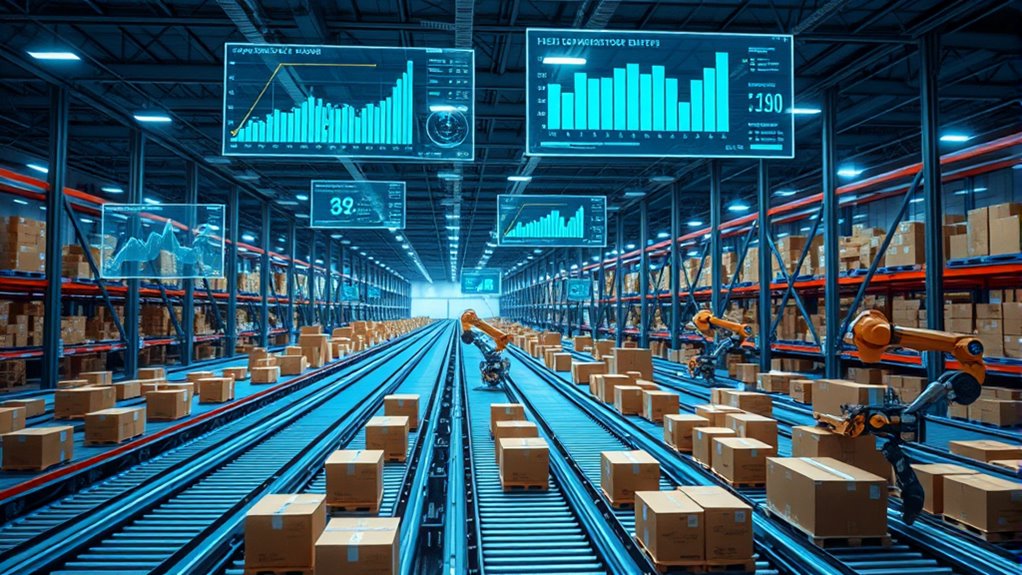Predictive intelligence keeps goods flowing in real time by integrating diverse data sources like sales, weather, and traffic to anticipate demand and potential disruptions. Using advanced analytics and machine learning, it helps you make proactive decisions about inventory, routing, and sourcing. This dynamic approach reduces delays, cuts costs, and boosts supply chain resilience. If you want to discover how these insights can transform your operations, there’s much more to explore beyond this overview.
Key Takeaways
- Integrates real-time data and machine learning to forecast demand and optimize inventory levels proactively.
- Evaluates external factors like weather and traffic to anticipate disruptions and reroute supply chains promptly.
- Uses predictive analytics to identify risks, enabling preemptive actions and maintaining continuous goods flow.
- Enhances operational efficiency through data-driven route planning and resource allocation.
- Supports supply chain agility by providing timely insights for strategic decision-making and responsiveness.

Predictive intelligence is transforming supply chains by leveraging data, machine learning, and statistical models to forecast future events and trends. It involves techniques like data mining, regression analysis, time series forecasting, and optimization algorithms, which work together to analyze both historical and real-time data sources. By integrating these diverse data streams, you gain more accurate insights, enabling you to move beyond just understanding past performance to proactively predicting what’s next. Machine learning enhances these predictions by continuously adapting models based on new data patterns, making forecasts more reliable over time.
Predictive intelligence uses data and machine learning to forecast supply chain trends and enhance decision-making.
When it comes to demand forecasting and inventory management, predictive intelligence plays a vital role in helping you anticipate shifts in consumer behavior. Analyzing past sales data alongside market signals allows you to plan more precisely, balancing procurement and inventory investments. This way, you can optimize stock levels, reducing costs associated with overstocking or stockouts. Real-time data insights empower warehouse managers to adjust replenishment strategies dynamically, ensuring that inventory levels stay aligned with actual demand. This scalability in inventory management allows your supply chain to adapt swiftly to changing market conditions. Accurate data integration further enhances these capabilities by providing a comprehensive view of supply chain performance.
Predictive intelligence also helps you identify potential disruptions before they occur. By evaluating external factors such as weather, traffic, tariffs, and social trends, models can flag vulnerabilities like transport delays or geopolitical risks. This foresight allows you to preemptively reroute shipments or switch sourcing options, minimizing the impact of disruptions. Additionally, supplier reliability is better managed through data on lead times and quality, enabling more resilient sourcing strategies. Incorporating regulatory compliance considerations ensures that your supply chain remains within legal frameworks while predicting risks. Anticipating risks supports your efforts to maintain supply chain resilience and ensure continuity despite unforeseen events.
Operational efficiency benefits considerably from predictive analytics as well. By optimizing resource allocation and reducing forecasting errors, you cut waste and lower operational costs. Data-driven decisions help streamline workflows, reduce delays, and improve collaboration across departments, breaking down silos. These efficiencies translate into lower inventory holding costs and more accurate budget planning for logistics. When combined with real-time visibility, predictive intelligence allows you to respond rapidly to demand fluctuations, optimizing routes and schedules to improve delivery times and customer satisfaction.
Ultimately, predictive intelligence offers your supply chain a strategic advantage. It fosters agility, resilience, and responsiveness, helping you identify new market opportunities and enhance existing processes. By leveraging predictive insights, you build a more adaptable supply ecosystem that keeps goods flowing smoothly in real time, meeting customer needs more effectively and maintaining a competitive edge.
Frequently Asked Questions
How Does Predictive Intelligence Impact Supply Chain Resilience?
Predictive intelligence boosts your supply chain resilience by helping you identify risks early and act proactively. It detects potential disruptions from suppliers, weather, or geopolitical events, allowing you to implement mitigation strategies before issues escalate. By forecasting demand and optimizing inventory, you reduce shortages and delays. This agility helps you respond faster to changes, minimize costs, and keep goods flowing smoothly, even during unpredictable or volatile conditions.
What Industries Benefit Most From Predictive Intelligence?
You’ll find logistics, retail, e-commerce, maritime shipping, ports, transportation, and fleet management benefit most from predictive intelligence. It helps you optimize inventory, streamline routes, prevent delays, and maintain equipment. With real-time data, you can forecast demand, improve customer satisfaction, reduce costs, and enhance operational efficiency. This technology empowers you to proactively manage risks and adapt quickly to changing conditions, ensuring smooth, reliable supply chain performance across these industries.
Are There Privacy Concerns With Real-Time Predictive Data?
Yes, there are privacy concerns with real-time predictive data. You might collect sensitive information like GPS locations, customer details, and shipment data, which increases the risk of breaches. Cyberattacks and unauthorized access are real threats, especially if security measures aren’t tight. To protect privacy, you need encryption, strict access controls, and compliance with laws like GDPR and CCPA. Transparency and vendor assessments also help safeguard data and maintain trust.
How Costly Is Implementing Predictive Intelligence Systems?
Implementing predictive intelligence systems can be quite costly. You’ll face high initial investments, often between $250,000 and over $1 million, for enterprise-grade AI, data infrastructure, and integration. Ongoing expenses include licensing fees, maintenance, and scaling costs. Plus, you’ll need to budget for employee training and change management, which can add to the overall expense. While automation helps, these systems require significant upfront and continuous investments to operate effectively.
What Skills Are Needed to Manage Predictive Intelligence Tools?
You need a mix of technical, analytical, change management, and interpersonal skills to manage predictive intelligence tools effectively. Be proficient in statistical modeling, data mining, and programming languages like Python or R. Develop strong problem-solving abilities, understand integration protocols, and stay adaptable to updates. Additionally, communicate clearly with stakeholders, lead change initiatives smoothly, and foster teamwork by demonstrating empathy and leadership, ensuring successful deployment and ongoing optimization of predictive systems.
Conclusion
By harnessing predictive intelligence, you keep your supply chain moving seamlessly in real time. It’s like having a crystal ball that helps you anticipate needs before they happen, reducing delays and boosting efficiency. So, why rely on guesswork when smarter solutions are at your fingertips? Embrace predictive intelligence now and guarantee your goods flow effortlessly—because staying ahead isn’t just an option, it’s a necessity in today’s fast-paced world.











